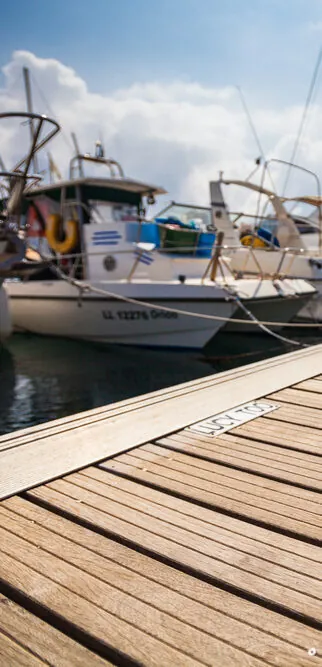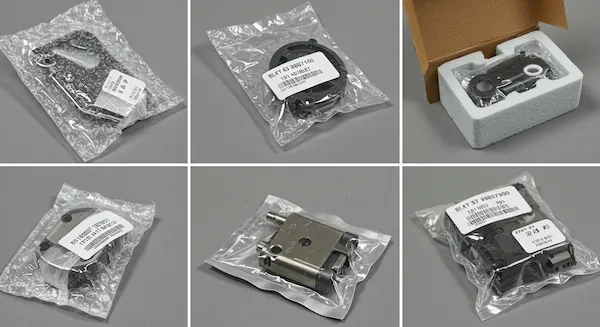
Shipping Fishing Equipment
Ship Your Fishing Equipment with Confidence
Protect your fishing equipment during transit. Safely ship reels, holders, tackle, and accessories, and trust FreightCenter for reliable and secure shipping solutions.
Shipping fishing equipment requires careful preparation to protect delicate, high-value gear such as rods, reels, tackle boxes, nets, and electronic devices like fish finders. To ensure your equipment arrives safely, fishing rods should be disassembled and placed in durable, hard-sided tubes or reinforced containers. Reels and tackle should be wrapped in protective padding, and hooks or lures should be stored in compartmentalized cases to avoid damage or injury during transit. Nets, waders, and soft goods like fishing vests or boots should be packed in moisture-resistant bags and cushioned with packing materials to prevent shifting.
Packaging your items in heavy-duty, double-walled boxes and filling any empty space with foam or bubble wrap provides an additional layer of protection. Proper labeling—such as “Fragile,” “This Side Up,” or “Sensitive Equipment”—ensures handlers take appropriate care during loading and unloading.
FreightCenter simplifies the process of shipping fishing equipment with our Less-Than-Truckload (LTL) freight options, ideal for transporting anything from a few rods to a full outfitter’s inventory. We connect anglers, retailers, and outdoor outfitters with reliable carriers across the country, offering discounted rates and flexible transit options. With real-time tracking, expert freight support, and over 25 years of logistics experience, FreightCenter ensures your gear arrives safely and on schedule.
🎣 Ready to ship fishing equipment with confidence? Get a free freight quote today and let FreightCenter hook you up with the best shipping solution.
Thousands of businesses trust FreightCenter to move their freight faster, smarter, and cheaper! From unbeatable rates to top-notch service, our customers are raving about their shipping success.
See why they keep coming back!
Award-Winning Service, Trusted by Shippers Everywhere!
- 2021, 2017 & 2016 Food Logistics’ Top Green Providers
- 2021 & 2018 Supply & Demand Chain Executives’ Pros to Know: Matthew Brosious
- 2020 & 2019 Top Food Logistics’ 3PL & Cold Storage Provider Award
- 2020 & 2019 Business Observer’s Top 500 Companies on the Gulf Coast
- 2020 & 2017 SmartWay® Transport Partner
- 2020 & 2017 Food Logistics’ Champions: Rock Stars of the Supply Chain
- 2020 Best of Palm Harbor Awards for Local Businesses
- 2017 Green Supply Chain Award from Supply & Demand Chain Executive
- 2017 Tampa Bay Business Journal Heroes at Work
- 2016, 2015, & 2012 Food Logistics Top 100 Software and Technology Providers
- 2013 Tampa Bay Business 100 by Tampa Bay Business Journal
- 2013 Top 100 Great Supply Chain Partners by SupplyChainBrain
- 2012 TIA Samaritan Award Honorable Mention
- 2012, 2011 & 2010 TBBJ Fast 50 Recipient
- 2013, 2011, & 2010 Diversity Business Top Businesses

Choosing The Right Freight Company to Ship Your Fishing Equipment
FreightCenter specializes in secure, cost-effective shipping for fishing equipment, including reels, holders, tackle, waders and accessories. With 25+ years of logistics expertise, we simplify the process by connecting you with trusted carriers and offering tailored freight solutions for both individual and bulk shipments. Our competitive rates ensure affordable shipping without sacrificing quality, whether you need specialized handling or expedited delivery for urgent orders. Backed by personalized customer support, we manage everything from quotes and tracking to paperwork and carrier coordination, so you can focus on your fishing adventures while we handle your shipping needs.
Trust FreightCenter for reliable, secure, and cost-effective equipment shipping.
How to Ship Fishing Equipment to Remote or Island Destinations

Shipping fishing equipment to remote or island destinations comes with unique challenges—including limited transportation options, extended transit times, and strict customs procedures. Whether you’re outfitting a charter operation, heading out on a personal angling adventure, or supplying a fishing lodge, advanced planning is key to ensuring your gear arrives safely, on time, and without unexpected costs or complications.
Most island deliveries rely on air or sea freight, and these modes may impose restrictions on certain items, such as lithium-powered fish finders or battery-operated gear. Consolidated freight forwarding services can help streamline shipments, reduce costs, and ensure compliance with international shipping regulations. Weather delays and seasonal changes can also affect transit schedules, so choosing a reliable carrier and booking well in advance is highly recommended.
Proper packaging and documentation are essential. Use waterproof, impact-resistant containers to protect rods, reels, electronics, and tackle from saltwater, humidity, and rough handling. Ensure all gear is securely padded and boxed, and fill out the necessary customs forms, import permits, and declarations for any restricted items to avoid border delays.
FreightCenter makes it easy to ship fishing gear to remote and offshore destinations. With flexible air, ocean, and ground freight options, we manage the logistics—from navigating customs requirements to securing the best shipping rates. Whether you need express delivery for a few essentials or bulk shipping for an entire operation, FreightCenter ensures your fishing equipment arrives safely and efficiently.
Planning a remote fishing trip or sending gear overseas? Get a free quote today and let FreightCenter take the stress out of shipping.
To create value for our customers by delivering customized shipping solutions that meet their unique needs and to fulfill shipping demands from simple to complex with expertise, guidance and ingenuity.
If you’re shipping smaller batches of fishing gear, Less-Than-Truckload (LTL) freight shipping is the ideal solution. This cost-effective method allows you to share truck space with other shipments, helping you save on transportation costs while still ensuring secure delivery. Whether you're sending rods, reels, tackle boxes, nets, or electronic accessories, LTL is perfect for fishing retailers, outfitters, or distributors needing to move partial loads efficiently. FreightCenter partners with a wide network of trusted LTL carriers to provide affordable, reliable service across the country.
For larger shipments of fishing equipment, Full Truckload (FTL) shipping offers dedicated transport that’s both secure and efficient. Ideal for bulk orders, store restocking, or equipment distribution, FTL reduces the risk of damage by minimizing transfers and handling. This method is best suited for retailers, manufacturers, or fishing resorts shipping large volumes of rods, tackle, bait, coolers, and other gear. FreightCenter customizes every truckload shipment to match your timing, packaging needs, and destination requirements—delivering your fishing equipment directly and safely.
Need your fishing gear delivered quickly? Whether you're restocking inventory before peak season, shipping to a tournament location, or fulfilling urgent orders, expedited freight shipping is your fastest option. FreightCenter's expedited services offer priority handling, faster transit times, and real-time tracking to ensure your rods, reels, and electronics arrive on time. From last-minute tournament prep to time-sensitive deliveries for coastal outfitters, our fast freight solutions help you stay ahead of the catch.
When shipping rare, custom, or high-value fishing equipment, specialized freight shipping provides the care and protection your gear deserves. FreightCenter offers white-glove services, temperature-controlled transportation, and advanced security features to safeguard collectibles like antique rods, custom lures, vintage reels, or high-end sonar systems. Whether you’re a collector, museum, or outfitter transporting premium inventory, we ensure safe handling, limited exposure to damage, and insurance options tailored to your needs.

FreightCenter is Here to Get You Fishing!
FreightCenter Knows How Important Your Fishing Gear Is!
FreightCenter understands the importance of delivering your fishing gear safely and on time. With over 25 years in the logistics industry, we are dedicated to providing the best shipping experience while keeping your costs low. We partner with over 50 carriers nationwide, allowing us to offer discounted rates that you won’t find anywhere else. Our tailored solutions include expedited shipping, white-glove services, and specialized freight options, ensuring that your reels, tackle, waders, and accessories arrive in perfect condition.
For added value, repeat customers can earn points for exclusive rewards every time they ship with us!
Ready to ship your Fishing Equipment? Our expert agents are here to help you find the best shipping solution for your needs. Get a free freight quote using our online tool, or call us at (800) 716-7608 today!
Frequently Asked Questions about Shipping Fishing Equipment

Q. What’s the best way to ship fishing rods?
Fishing rods should be disassembled (if possible) and placed in durable, hard-sided tubes or reinforced boxes. Padding the tips and using shock-absorbing materials helps prevent breakage during transit.
Q. Can I ship fishing gear with hooks and lures attached?
It’s best to remove hooks and lures from rods and store them separately in tackle boxes or protective cases. This prevents damage to other equipment and reduces the risk of injury during handling.
Q. Is LTL shipping cost-effective for small fishing gear shipments?
Yes, Less-Than-Truckload (LTL) shipping is ideal for smaller batches of fishing gear. FreightCenter helps you save money by consolidating your shipment with others and connecting you to trusted LTL carriers nationwide.
Q. How should I package reels and electronic devices like fish finders?
Reels and electronics should be wrapped in anti-static or padded materials and packed in waterproof containers. Keep items secure to prevent internal movement during transport.
Q. Can I ship fishing gear internationally?
Yes, but you must follow international shipping regulations, including customs documentation and potential import/export restrictions. FreightCenter’s team can help you navigate the process for global deliveries.
Q. What shipping method is best for delivering fishing equipment to islands or remote locations?
For remote or island destinations, air or sea freight is typically required. FreightCenter offers tailored solutions that account for limited carrier options, seasonal transit delays, and customs requirements.
Q. Are there restrictions on shipping lithium-powered fishing equipment?
Yes, items like lithium-powered fish finders or GPS devices may be classified as hazardous materials. FreightCenter ensures proper classification, labeling, and compliance with federal transport regulations.
Q. Can I insure my fishing gear during shipment?
Absolutely. FreightCenter offers insurance options for added peace of mind, especially when shipping high-value items like premium rods, reels, or electronics.
Q. What’s the average cost to ship fishing equipment?
Costs vary based on weight, dimensions, distance, and freight mode. Use FreightCenter’s free quote tool to get an accurate shipping estimate tailored to your needs.
Q. How do I prepare fishing gear for bulk shipments?
Group items by type, use reinforced crates or heavy-duty boxes, and clearly label each container. FreightCenter can assist with freight consolidation and palletizing for bulk orders.
Q. Is it possible to expedite a fishing gear shipment?
Yes. FreightCenter offers expedited freight services with priority handling and reduced transit times—ideal for last-minute tournament shipments or retail restocks.
Q. How do I avoid damage when shipping fragile or high-end fishing gear?
Use protective cases, cushion items thoroughly, and avoid overpacking. FreightCenter also offers white-glove services and custom crating options for sensitive shipments.
Q. Can I schedule a residential pickup or delivery for fishing equipment?
Yes. FreightCenter arranges residential pickups and deliveries with liftgate service when needed. Be sure to mention access limitations when booking your shipment.
3 Unique Tips for Shipping Fishing Equipment

Bundle Gear by Material Type to Optimize Freight Class
Freight class is partly determined by density and how easily items can be stowed. Grouping similar materials—like all metal gear in one crate and soft goods (like waders and tackle bags) in another—can help you secure a lower freight class and reduce costs. Mixing dense and lightweight items can sometimes lead to higher classification and unnecessary fees.

Use Collapsible or Stackable Containers to Reduce Dimensional Weight
Shipping costs often depend on the space your shipment occupies, not just its weight. When possible, pack rods in telescopic tubes, fold down nets, and collapse storage bins or tackle boxes. Stackable, uniform containers reduce wasted space on pallets, allowing you to fit more gear in fewer shipments—cutting down on overall freight spend.

Schedule Shipments Mid-Week to Avoid Peak Rates
Freight demand tends to spike on Mondays and Fridays. If your fishing equipment shipment isn’t urgent, consider scheduling pickups on Tuesdays or Wednesdays when rates can be lower, carrier availability is higher, and transit times may be faster due to reduced warehouse congestion.

